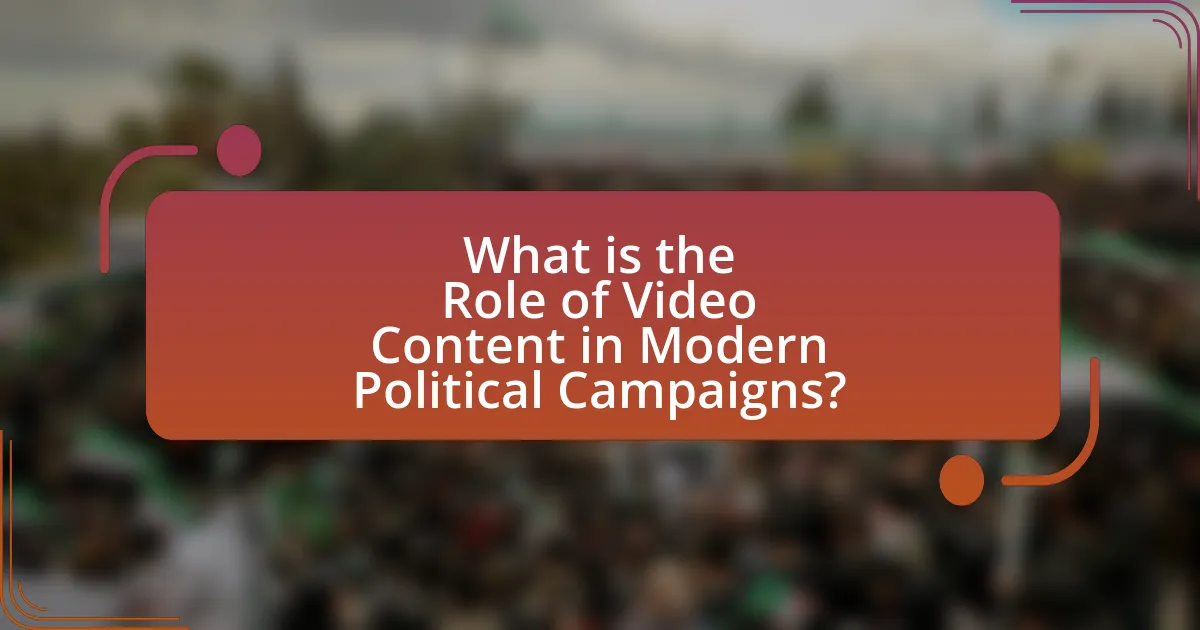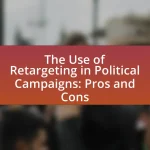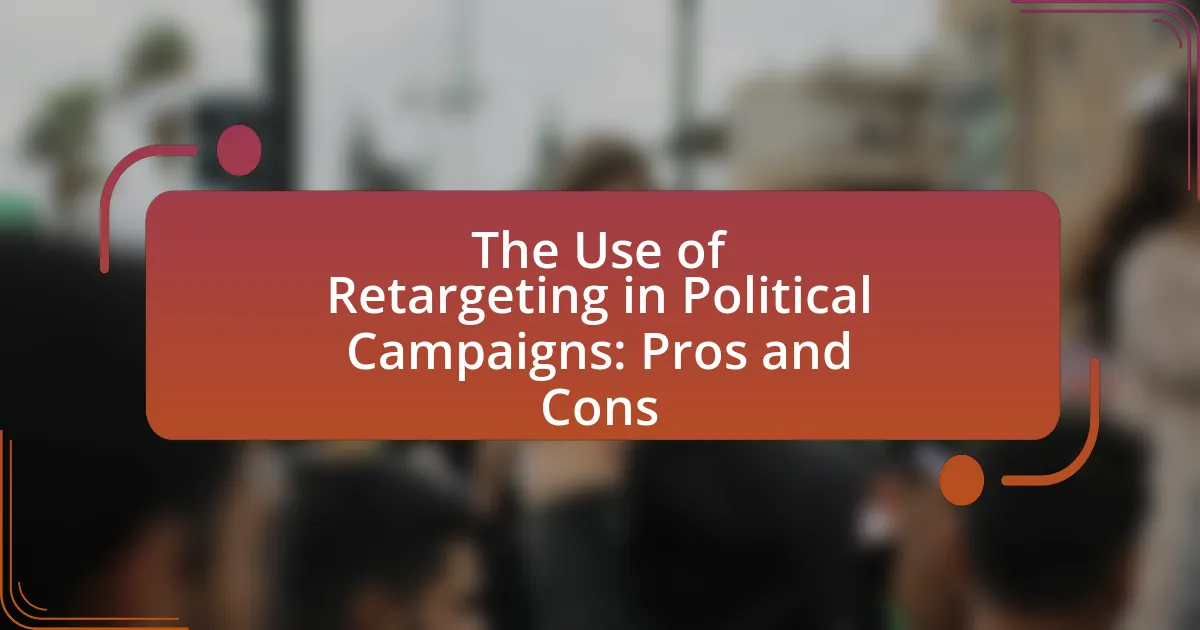Video content is a pivotal element in modern political campaigns, significantly enhancing voter engagement and message delivery. The article explores the evolution of video usage from traditional television ads to dynamic digital strategies, highlighting the impact of technological advancements and platform-specific content. It discusses the psychological effects of video on voters, the types of video commonly used in campaigns, and the challenges faced by political entities in video production. Additionally, best practices for creating effective video content and methods for measuring its success are outlined, emphasizing the importance of clear messaging and audience engagement in achieving campaign goals.

What is the Role of Video Content in Modern Political Campaigns?
Video content plays a crucial role in modern political campaigns by enhancing voter engagement and conveying messages effectively. Campaigns utilize video to create emotional connections, showcase candidates’ personalities, and communicate policy positions succinctly. For instance, studies have shown that video content increases information retention by up to 95% compared to text alone, making it a powerful tool for influencing public opinion. Additionally, platforms like social media amplify the reach of video content, allowing campaigns to target specific demographics and generate viral moments that can significantly impact election outcomes.
How has video content evolved in political campaigning?
Video content in political campaigning has evolved from traditional television advertisements to dynamic, multi-platform strategies that leverage social media and digital platforms. Initially, political campaigns relied heavily on broadcast television for reaching voters, with scripted ads focusing on key messages and candidate images. Over time, the rise of the internet and social media transformed this landscape, allowing campaigns to create and distribute video content that is more engaging and interactive.
For instance, the 2008 Obama campaign effectively utilized platforms like YouTube to reach younger voters, showcasing a shift towards user-generated content and viral marketing. By 2020, campaigns increasingly adopted live streaming, short-form videos, and targeted ads on platforms such as Instagram and TikTok, reflecting changing viewer habits and preferences. This evolution is supported by data indicating that video content significantly enhances engagement, with studies showing that social media posts containing videos receive 48% more views than those without.
What technological advancements have influenced video content in campaigns?
Technological advancements such as high-definition video, live streaming, and artificial intelligence have significantly influenced video content in campaigns. High-definition video allows for clearer and more engaging visuals, enhancing viewer retention and emotional connection. Live streaming enables real-time interaction with audiences, fostering a sense of immediacy and authenticity. Artificial intelligence facilitates personalized content delivery and targeted advertising, optimizing engagement based on viewer preferences and behaviors. These advancements have transformed how campaigns create, distribute, and analyze video content, leading to more effective communication strategies.
How do different platforms impact the use of video in political campaigns?
Different platforms significantly impact the use of video in political campaigns by shaping audience engagement, content format, and distribution strategies. For instance, platforms like Facebook and Instagram prioritize short, visually engaging videos that cater to quick consumption, while YouTube supports longer, more in-depth content that allows for detailed storytelling. According to a 2020 Pew Research study, 73% of adults reported using YouTube, making it a crucial platform for reaching a broad audience with comprehensive campaign messages. In contrast, TikTok’s rise emphasizes creative, entertaining video formats that resonate with younger voters, influencing how campaigns craft their messages to align with platform-specific trends. Thus, the choice of platform directly affects the style, length, and effectiveness of video content in political campaigns.
Why is video content important for political candidates?
Video content is important for political candidates because it enhances engagement and allows for effective communication of their messages. Research indicates that video content can increase viewer retention by 95% compared to text, making it a powerful tool for conveying complex political ideas and policies. Additionally, platforms like YouTube and social media have become primary sources of information for voters, with 73% of adults reporting that they use these platforms to stay informed about political issues. This demonstrates that candidates who utilize video can reach a broader audience and create a more personal connection with potential voters.
What psychological effects does video content have on voters?
Video content significantly influences voters’ psychological responses, primarily through emotional engagement and information retention. Research indicates that emotionally charged videos can enhance voter motivation and increase the likelihood of voting behavior. For instance, a study published in the journal “Political Communication” by Brader (2006) found that emotionally evocative political ads led to higher levels of engagement and persuasion among viewers. Additionally, video content can shape perceptions of candidates by highlighting specific traits or narratives, which can lead to biased evaluations based on the emotional tone of the content. This effect is further supported by findings from the Pew Research Center, which show that voters are more likely to remember and be influenced by video messages compared to text-based information.
How does video content enhance candidate visibility and engagement?
Video content enhances candidate visibility and engagement by providing a dynamic and relatable medium for communication. This format allows candidates to showcase their personality, policies, and campaign messages in a visually compelling way, which can significantly increase audience retention and interest. Research indicates that video content is processed 60,000 times faster than text, making it an effective tool for conveying complex information quickly. Additionally, platforms like social media prioritize video content, leading to higher reach and engagement rates; for instance, video posts on Facebook receive 48% more views than static images. This combination of speed, relatability, and platform preference solidifies video content as a crucial element in modern political campaigns.
What types of video content are commonly used in political campaigns?
Political campaigns commonly use several types of video content, including promotional ads, candidate speeches, issue advocacy videos, testimonials, and live-streamed events. Promotional ads are designed to introduce candidates and their platforms, often highlighting key messages and visuals to attract voters. Candidate speeches capture the candidate’s rhetoric and vision, while issue advocacy videos focus on specific policies or social issues to sway public opinion. Testimonials feature endorsements from supporters or influential figures, adding credibility to the campaign. Live-streamed events allow real-time engagement with voters, fostering a sense of community and immediacy. These video formats are effective in reaching diverse audiences and enhancing voter engagement, as evidenced by the significant increase in online video consumption during election cycles.
What role do advertisements play in political video content?
Advertisements serve as a crucial mechanism for conveying political messages in video content, effectively shaping public perception and influencing voter behavior. They are designed to highlight candidates’ platforms, promote key issues, and mobilize support through persuasive visuals and narratives. Research indicates that political advertisements significantly impact voter decision-making; for instance, a study by the Pew Research Center found that 62% of voters reported that campaign ads influenced their choices in elections. This demonstrates the effectiveness of advertisements in reaching and engaging audiences, ultimately playing a pivotal role in modern political campaigns.
How do live streams and debates utilize video content effectively?
Live streams and debates utilize video content effectively by engaging audiences in real-time and providing a platform for direct interaction. This immediacy allows candidates to showcase their personalities and policies dynamically, fostering a sense of connection with viewers. For instance, during the 2020 U.S. presidential debates, candidates used video clips to highlight key issues, which enhanced viewer understanding and retention of their messages. Additionally, platforms like YouTube and Facebook Live enable instant feedback through comments and reactions, further increasing audience involvement and shaping the narrative around the candidates.
How does video content influence voter behavior?
Video content significantly influences voter behavior by shaping perceptions and increasing engagement with political messages. Research indicates that voters are more likely to remember and be persuaded by visual content, as studies show that video can enhance emotional responses and create a stronger connection to candidates. For instance, a study by the Pew Research Center found that 78% of voters reported that video content helped them better understand candidates’ positions. Additionally, video platforms like YouTube and social media have become primary sources for political information, with 60% of voters stating they have watched political videos online, further demonstrating the medium’s impact on voter decision-making.
What challenges do political campaigns face when using video content?
Political campaigns face several challenges when using video content, including high production costs, the need for effective targeting, and the risk of misinformation. High production costs can limit the ability of campaigns to create high-quality videos that resonate with voters, as professional video production can be expensive. Effective targeting is crucial, as campaigns must ensure their videos reach the right audience; failure to do so can result in wasted resources and low engagement. Additionally, the risk of misinformation can undermine the credibility of a campaign, as videos can be easily manipulated or taken out of context, leading to potential backlash and loss of trust among voters.
What are best practices for creating effective political video content?
Effective political video content should be concise, engaging, and tailored to the target audience. Research indicates that videos under two minutes retain viewer attention better, making brevity essential for conveying key messages. Additionally, incorporating storytelling elements can enhance emotional connection; for instance, a study by the Pew Research Center found that narratives in political messaging significantly increase viewer engagement. High-quality visuals and sound are also critical, as poor production can undermine credibility. Furthermore, optimizing videos for social media platforms, including captions for accessibility, ensures broader reach and engagement.
How can campaigns measure the success of their video content?
Campaigns can measure the success of their video content through metrics such as view count, engagement rate, conversion rate, and audience retention. View count indicates the number of times the video has been watched, providing a basic measure of reach. Engagement rate, calculated by assessing likes, shares, comments, and interactions, reflects how well the content resonates with the audience. Conversion rate tracks the percentage of viewers who take a desired action, such as signing up for a newsletter or donating, directly linking video content to campaign goals. Audience retention measures how long viewers stay engaged with the video, highlighting its effectiveness in maintaining interest. These metrics collectively provide a comprehensive view of video performance, enabling campaigns to adjust strategies based on data-driven insights.
What common pitfalls should campaigns avoid in video production?
Campaigns should avoid several common pitfalls in video production, including poor planning, lack of clear messaging, and neglecting audience engagement. Poor planning can lead to disorganized shoots and missed deadlines, which can compromise the quality of the final product. A lack of clear messaging can confuse viewers and dilute the campaign’s core message, making it less impactful. Additionally, neglecting audience engagement, such as failing to respond to comments or not tailoring content to the target demographic, can result in lower viewer retention and reduced effectiveness of the campaign. These pitfalls can significantly hinder the overall success of video content in political campaigns.




